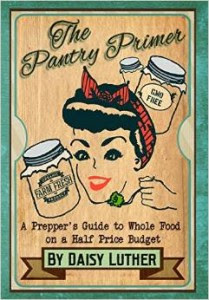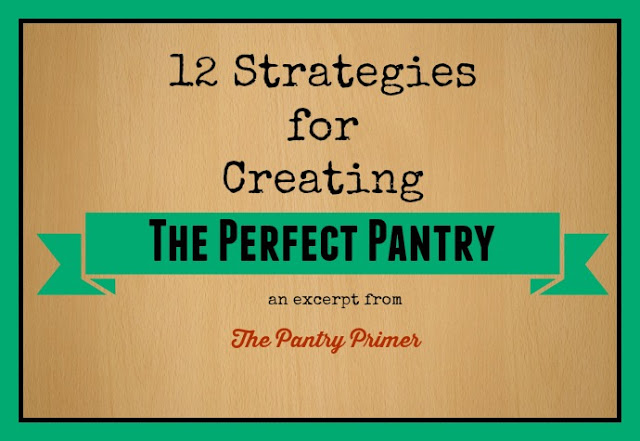12 Strategies for Creating the Perfect Pantry
By Daisy Luther
There are a lot of different ways to go about building your pantry. While each style has its pros and cons, I think that adhering to any one strategy alone leaves some gaps in your food preparedness. Personally, I’m a fan of combining the best of each world based on the needs of your particular family. Enjoy this excerpt from the updated version of my book, The Pantry Primer.
Excerpt from The Pantry Primer: A Prepper’s Guide to Whole Food on a Half-Price Budget
Looking for a strategy to create your own pantry? There are a lot of different philosophies out there, but I think it boils down to three basic types of food supplies:
- The Bunker Pantry
- The Agrarian Pantry
- The Bargain-Hunter’s Pantry
This doesn’t mean you are stuck with just one strategy, however. All of the types have positives and negatives. Learn about these food storage ideologies and then take the most applicable components for your situation. Combine them to create your own version of the Perfect Pantry. Use strategies from each type to create a stockpile that meets your family’s needs.
The Bunker Pantry
This is the most “hardcore” of the food storage types. A Bunker Pantry is the type of food supply that could keep you going for the next ten years without a single trip to the store. Sure, it might be a little bit boring and lacking in variety, but it is a supply that will see you through any disaster while allowing you to remain in your shelter. This type of pantry focuses on huge quantities of long-term foods, repackaged carefully to resist spoilage due to pests or the elements.
If this is the type of pantry you’d like to build, focus on staples such as wheat, rice, dried beans, salt, and sugar. These foods can be purchased in bulk and repackaged by the user, or you can purchase them already packaged up through vendors like the Latter Day Saints (LDS) warehouse or online food storage websites.
Variety can be added to this type of pantry through commercially canned fruits, vegetables, and meats. When looking for sales on these items, be sure to check the expiration dates. If you are storing for the long term you want to be certain to grab cans with the longest shelf life.
Another great way to add fruits, veggies, meats, and dairy to your Bunker Pantry is through the addition of freeze-dried foods. If properly packaged, these foods can last up to 25 years. As long as you have water to rehydrate these foods, your diet can remain fairly normal throughout a long-term scenario. Imagine how decadent you’d feel, rehydrating the ingredients to make a fluffy cheese omelet with ham and peppers in the midst of an off-grid situation.
It takes a lot of space to store this much food, so generally a dedicated area must be used as a storeroom. Items should be clearly marked with expiration dates, and when that date draws near, the items should be rotated in to the family’s kitchen.
The Agrarian Pantry
This type of pantry is the kind our ancestors had. Most of the purchases are made during the growing season and only small shopping trips are needed to supplement this throughout the year. It combines enough basic staples for the year ahead with enough of your preserved harvest to get you through until the next growing season. (This is primarily the type of pantry that we keep in our family, with a few of the other strategies added to increase the usefulness of our stockpile.).
To build an Agrarian Pantry, stock up on a year’s supply of basics like grains, baking items, tea, coffee, and dried beans. Then focus your efforts on acquiring items in season and preserving them when they are at their peak. Try your hand at canning, dehydrating, and root cellaring. Items can be grown on your own property or purchased by the bushel from local farms and orchards.
Look into purchasing a side of beef and a side of pork to add to your pantry. One purchase per year is sufficient for most families, and your price per pound drops dramatically when you buy meat in this type of quantity. Remember not to put all of your faith in the deep freezer, however, because a grid-down scenario could leave you with a smelly mess and a large lost investment. Try canning, smoking, salting and dehydrating for the bulk of your meat purchases.
This type of pantry must be replenished every year. Basically, the items in your pantry are purchased and put back with the intention of consuming them within the next 12 months. Extra supplies should ideally be stored to make up for shortfalls caused by a poor harvest.
The Bargain-Hunter’s Pantry
This is the type of pantry made famous by the extreme couponing shows. Using a variety of strategies, people can amass an enormous quantity of food for very little money. Couponing, sale shopping, bartering, and buying from outlet stores and warehouses can help to create a pantry full of packaged items.
 While this is a great way to get started or to supplement your other strategies, it’s my least favorite way to create a stockpile. First, much of what you are acquiring is highly processed. Secondly, without a lot of personal discipline, you aren’t building a balanced pantry, but just stockpiling whatever is the cheapest. If you use this method, you must be extremely careful not to end up with a pantry full of carbs, but no protein, fruits, and veggies. (I don’t care what the kids say, 25 cent ketchup is not a vegetable.)
While this is a great way to get started or to supplement your other strategies, it’s my least favorite way to create a stockpile. First, much of what you are acquiring is highly processed. Secondly, without a lot of personal discipline, you aren’t building a balanced pantry, but just stockpiling whatever is the cheapest. If you use this method, you must be extremely careful not to end up with a pantry full of carbs, but no protein, fruits, and veggies. (I don’t care what the kids say, 25 cent ketchup is not a vegetable.)
Warnings aside, you can build up a huge amount of food on a very limited budget and still be relatively healthy if you are a smart shopper.
When building a Bargain-Hunter’s Pantry, consider the following suggestions to create more balance:
- Look for the items with the least number of ingredients – don’t stock your shelves with chemistry projects, no matter how cheap they are.
- Strive for balance by creating an inventory list to keep in your purse so that you know which types off foods are needed to keep your family healthy. (Are you short of protein sources? Veggies? Healthy fats?)
- Don’t add it to your stockpile merely because it’s cheap, particularly if your storage space is limited.
- Be sure to rotate the items into your kitchen by expiry date. Often the items that have the deepest discounts are the closest to expiration. You aren’t saving money if you end up throwing out spoiled food.
Combine the Best of Each Strategy to Build the Perfect Pantry
The Perfect Pantry combines the three strategies listed above to create the optimal supply for the needs of your particular family.
The key is organization. Keep the following tips in mind to create the best possible pantry.
- Keep an up-to-date inventory so that you know what you have
- Catalog your coupons by type and expiration date
- Track the sales cycles
- Keep your products rotated into your kitchen so that you don’t lose foods to missed expiration dates.
- Store longer-term foods in optimum conditions to prolong their viability.
- Maintain a list of what is needed to balance your pantry nutritionally so that you can focus on those items when an unexpected bargain pops up.
- Buy pantry staples (like beans and grains) in the largest quantities you can manage in order to maximize your savings.
- Remember the adage “Store what you eat and eat what you store” – it isn’t a bargain if you purchase something no one in your family will eat.
- Supplement your pantry by growing as much as possible in your particular circumstances, even if you are just adding a windowsill herb and salad garden.
- Tap into your inner hunter-gatherer with strategies like foraging, fishing, snaring, and hunting.
- Purchase seasonally and in large quantities from local growers (or harvest from your own gardens).
- Become a food preservation expert and stock up on the necessary tools and supplies.
Here’s How the 2nd Edition of The Pantry Primer is Different
The first book was our personal story about building a pantry, based on the blog posts that I wrote throughout the journey. Readers had asked that I put all of the information together in one place, and the original version of The Pantry Primer was born.
But…there just wasn’t enough information in that book. I’ve spent the last year since it was published reading messages, reviews, and comments, and it was clear that a lot of expansion was needed.
So, this book is almost triple the size of the original version, Instead of only personal accounts, it is a comprehensive guide containing detailed, step-by-step instructions for those of you who are creating a food storage supply.
We’re going to talk about food storage from beginning to end.
What you can start learning today:
- The components of a pantry.
- Personalizing your pantry.
- Prepping for those with dietary restrictions.
- Shopping the Preppernomics way.
- Week-by-week shopping lists and menus that you can gear towards your budget.
- How and where to store all of that food.
- Pantry inventory and maintenance.
- 25 frugal and delicious recipes as a bonus!
- How to make items that most people purchase
 |
| Get your copy today! The second edition of The Pantry Primer is 230 jam-packed pages for only $19.95! |
If You’re New to Prepping
Please don’t be discouraged when you see all of the doom and gloom out there. You can take the most important step today…the step of getting started. You’ll have a year’s supply of food in no time at all!
Daisy Luther lives in a small village in the Pacific Northwestern area of the United States. She is the author of The Organic Canner, The Pantry Primer: A Prepper’s Guide to Whole Food on a Half-Price Budget, and the soon-to-be-released The Prepper’s Water Survival Guide: Harvest, Treat, and Store Your Most Vital Resource. On her website, The Organic Prepper, where this article first appeared. Daisy uses her background in alternative journalism to provide a unique perspective on health and preparedness, and offers a path of rational anarchy against a system that will leave us broke, unhealthy, and enslaved if we comply. Daisy’s articles are widely republished throughout alternative media. You can follow her on Facebook, Pinterest, and Twitter.




